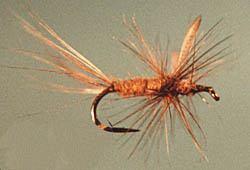
 Thor-X Fly By James Birkholm Photo by James Birkholm
|
|
|
Materials List:
|
Tying Instructions:2. Hold two wings on top of hook with left hand. Take two loose thread winds over wings and bind down. Lift wings up and wind thread in front to hold. 3. Wind to bend and tie on tail. Use moose mane or several barbels from a good hackle. Separate into two and flair each to 45 degrees. 4. Wind thread to wings. Tie in one hackle feather. 5. Apply dubbing and build up thorax. Leave thread near the eye. 6. Wrap hackle in a criss-cross (X) using thorax as a base to hold in place. Take two turns in each direction. 7. Tie off hackle. Whip finish and cement.
Tying Tips
|
[ HOME ]
[ Search ] [ Contact FAOL ] [ Media Kit ]